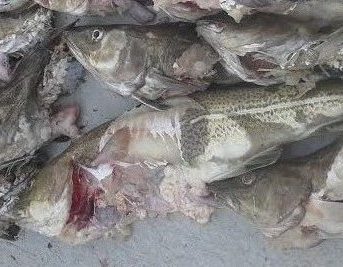Tag Archives: Fish Predation

Seal hunt proponents hope new evidence sways skeptical fisheries officials
Three new studies being prepared for publication suggest that recovered populations of seals and sea lions in west coast waters could be having an outsized impact on the survival of the three most troubled Pacific salmon species — chinook, coho and sockeye. “Most of the drop in survival of chinook and coho in the Georgia Strait since the 1980s is likely due to seals eating juvenile fish during their first summer in the ocean,” said Carl Walters, a professor emeritus at UBC’s Institute for the Oceans and Fisheries. Estimates suggest that seals may be consuming about five million juvenile coho each year, or about half of the juveniles that enter the area from streams and rivers. Up to 15 million chinook juveniles meet the same fate, about one third of that population. >click to read< 09:21
Fishermen Catch Giant Swordfish, SHOCKED When They Cut It Open
 A bizarre incident was recently caught on video after a few fishermen reeled in a massive swordfish. However, the situation got strange after they began to cut it open, only to make a surprising discovery inside. The location of the incident is currently unknown, but video of the ordeal is going viral after seeing what the day’s catch produced. We all know that fishermen bring things in on a daily basis and most of them have their own niche markets for whatever they want. As it turns out, these guys specialized in swordfish and managed to bring in a rather large one before attempting to dress it. However, things would take a turn as the men on the boat noticed that the large fish had a rather swollen abdomen that just wasn’t normal. Watch the video here 07:59
A bizarre incident was recently caught on video after a few fishermen reeled in a massive swordfish. However, the situation got strange after they began to cut it open, only to make a surprising discovery inside. The location of the incident is currently unknown, but video of the ordeal is going viral after seeing what the day’s catch produced. We all know that fishermen bring things in on a daily basis and most of them have their own niche markets for whatever they want. As it turns out, these guys specialized in swordfish and managed to bring in a rather large one before attempting to dress it. However, things would take a turn as the men on the boat noticed that the large fish had a rather swollen abdomen that just wasn’t normal. Watch the video here 07:59

A Must Read! FishNet USA / Dogfish and seals and dolphin, oh my!
The bottom line is that while commercial fishermen from North Carolina to Maine are at work catching on the order of half a million mt of fish and shellfish a year, it appears as if it takes an annual 20,000,000 tons or more to keep all those marine mammals and low-value spiny dogfish and various other predatory fish going. How much of that 20 million tons is commercially/recreationally valuable species or the forage species that sustain them? No one seems awfully interested in finding that out, but they sure should be. Read the rest here 10:55
















































